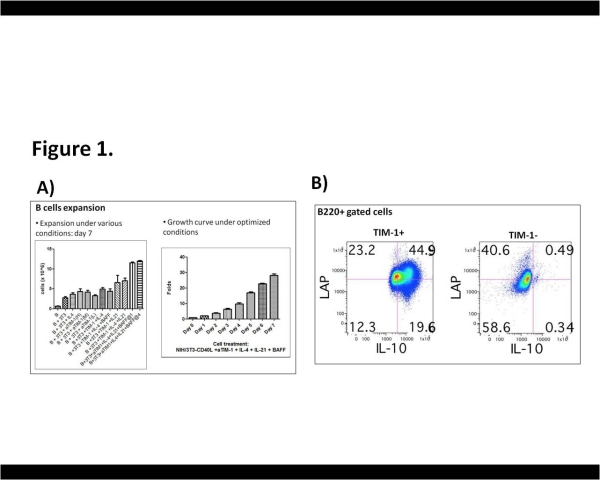Expansion of Regulatory B-Cells and Their Potential Role in Transplantation Tolerance.
Massachusetts General Hospital, Boston, MA.
Meeting: 2016 American Transplant Congress
Abstract number: 181
Session Information
Session Name: Concurrent Session: B Cells in Rejection and Tolerance: Animal Models
Session Type: Concurrent Session
Date: Monday, June 13, 2016
Session Time: 2:30pm-4:00pm
 Presentation Time: 3:06pm-3:18pm
Presentation Time: 3:06pm-3:18pm
Location: Room 310
Introduction
Regulatory B (Bregs) cells, B cells which produce IL-10, have been shown to play a critical role in immune homeostasis and autoimmunity models. Despite the evidence for Bregs in non-transplant settings, a clear role for B cells or Bregs in the maintenance of induced transplant tolerance has not yet been well-established.
Experimental analysis of Bregs has been hindered because of their small numbers. Bregs represent ~1-2% of adult mouse spleen B cells, and antigen-specific Bregs are even a rarer population. Here we describe a protocol to induce Breg expansion in vitro (Fig.1A) and secretion of TGF-β and IL-10 under various conditions (Fig.1B). We are currently testing the ability of these ex vivo expanded Bregs to prolong islet allograft survival.
Methods
Splenocytes were harvested from C57BL/6 mice. B cells were purified by negative selection (CD90.2 kit/Milentyi) and cultured with irradiated NIH 3T3-CD40L cells for 7 days. Cells were treated on day 0 and 3 with combinations of anti-TIM-1, IL-4, IL-21, and BAFF (Fig.1A). Expansion between different treatment groups was compared using ANOVA statistics. P values <0.05 were considered statistically significant.
Results
In-vitro growth of B cells with NIH 3T3-CD40L cells and concomitant treatment with anti-TIM-1, IL-4, IL-21, and BAFF resulted in nearly 30 fold expansion and increased percentage of Bregs under optimal conditions. The difference in fold-expansion under various conditions was statistically significant with p <0.0001 (Fig. 1A). Further analyses of expanded B cells showed a high percentage of TIM-1+ B cells expressing IL-10 and TGF-β (Fig. 1B), both essential for Breg activity. Delivery of cells co-expressing these two inhibitory cytokines may provide an effective anti-rejection strategy and promote transplantation tolerance induction.
Conclusion
The spleen regulatory B cell subset with the functional capacity to express IL-10 (B10 cells) modulates immune responses. Expansion of Bregs ex vivo will facilitate experimental studies dissecting their mechanism of action and ultimately Bregs may be an effective cell therapy for prevention or treatment of rejection and as an adjunct in gaining transplant tolerance.

CITATION INFORMATION: Amundsen B, Deirawan H, Kim J, Markmann J. Expansion of Regulatory B-Cells and Their Potential Role in Transplantation Tolerance. Am J Transplant. 2016;16 (suppl 3).
To cite this abstract in AMA style:
Amundsen B, Deirawan H, Kim J, Markmann J. Expansion of Regulatory B-Cells and Their Potential Role in Transplantation Tolerance. [abstract]. Am J Transplant. 2016; 16 (suppl 3). https://atcmeetingabstracts.com/abstract/expansion-of-regulatory-b-cells-and-their-potential-role-in-transplantation-tolerance/. Accessed December 27, 2025.« Back to 2016 American Transplant Congress
